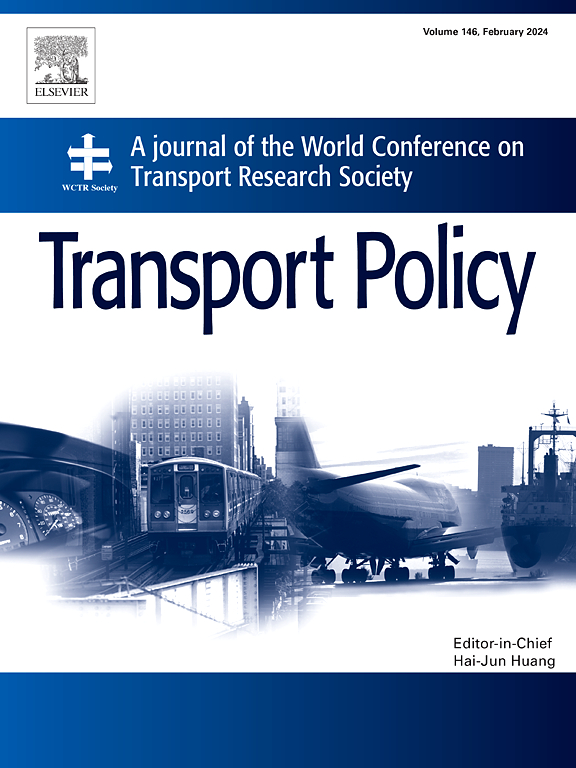哪里的停车政策最受欢迎?住宅小区和停车特征对公众可接受性影响的实证研究
IF 6.3
2区 工程技术
Q1 ECONOMICS
引用次数: 0
摘要
停车政策是减少汽车使用和改善城市社区宜居性的关键因素,因为它们将交通和土地使用联系起来。然而,政策制定者面临的挑战是设计停车政策,有效地解决当地的停车问题,同时确保在同一社区内的可接受性。我们的实证分析旨在根据居民的可接受程度,制定不同停车政策的类型。此外,我们还研究了空间差异对停车政策可接受性的影响,重点是居住区和停车特征。我们的研究结果来自一项定量家庭调查(N = 1186),我们在德国两个城市达姆施塔特和法兰克福的八个社区进行了调查。利用主成分分析(PCA)对31项初始停车政策进行分析,我们确定了六种政策类型:(1)停车限制和执法;(2)为宜居性而转换停车位;(3)为移动服务而转换停车位;(4)停车位转换伴随附加措施;(5)增加社区车库;(6)限制suv停车位。我们的研究结果表明,推动措施是最受欢迎和最不受欢迎的政策之一,对suv的限制通常比对普通汽车的限制更受欢迎。此外,我们发现停车位转换的可接受性取决于拟议的替代土地用途和相应的附加措施。尽管存在一些差异,但居民更支持将停车位转换为宜居性(例如绿化),而不是替代移动服务(例如汽车共享站)。我们的研究结果还强调了社区层面在制定停车政策时的重要作用。多变量分析表明,居住小区和停车特征(如通常停车位置、停车时间和离家距离)会影响停车政策的可接受性。因此,政策制定者可能会考虑改变一个社区的当地停车情况,政策要解决的具体目标群体,以及街边停车改造对居民的好处。本文章由计算机程序翻译,如有差异,请以英文原文为准。
Where are parking policies most popular? Empirical findings about the influence of the residential neighbourhood and car parking characteristics on public acceptability
Parking policies are a key factor in reducing car usage and improving liveability in urban neighbourhoods, as they link transport and land use. However, policymakers face the challenge of designing parking policies that effectively address local car parking issues while ensuring acceptability within the same neighbourhood. Our empirical analysis aims to develop a typology of different parking policies based on residents’ acceptability. Furthermore, we investigate the influence of spatial differences on the acceptability of parking policies, focusing on the residential neighbourhood and car parking characteristics. We derive our findings from a quantitative household survey (N = 1186) we conducted in eight neighbourhoods in the two German cities of Darmstadt and Frankfurt am Main. Applying principal component analysis (PCA) to 31 initial parking policies, we identify six policy types: (1) parking restrictions and enforcement, (2) conversion of parking space for liveability, (3) conversion of parking space for mobility services, (4) parking space conversion accompanied by additional measures, (5) additional neighbourhood garages and (6) limited parking for SUVs. Our results show that push measures are both among the most accepted and rejected policies, with restrictions for SUVs being generally more popular than those for regular cars. Moreover, we find that the acceptability of the conversion of parking spaces depends on the proposed alternative land use and accompanying additional measures. Despite some disparities, residents are more supportive of parking space conversions for liveability (e.g. greenery) than for alternative mobility services (e.g. car sharing stations). Our results also highlight the important role of the neighbourhood level when setting parking policies. Multivariate analyses indicate that the residential neighbourhood and car parking characteristics, such as the usual parking location, duration and distance from home, influence the acceptability of parking policies. Policymakers might, therefore, consider the local parking situation to be changed in a neighbourhood, the specific target groups to be addressed by a policy and the benefits for residents to be promoted by a transformation of on-street car parking.
求助全文
通过发布文献求助,成功后即可免费获取论文全文。
去求助
来源期刊

Transport Policy
Multiple-
CiteScore
12.10
自引率
10.30%
发文量
282
期刊介绍:
Transport Policy is an international journal aimed at bridging the gap between theory and practice in transport. Its subject areas reflect the concerns of policymakers in government, industry, voluntary organisations and the public at large, providing independent, original and rigorous analysis to understand how policy decisions have been taken, monitor their effects, and suggest how they may be improved. The journal treats the transport sector comprehensively, and in the context of other sectors including energy, housing, industry and planning. All modes are covered: land, sea and air; road and rail; public and private; motorised and non-motorised; passenger and freight.
 求助内容:
求助内容: 应助结果提醒方式:
应助结果提醒方式:


